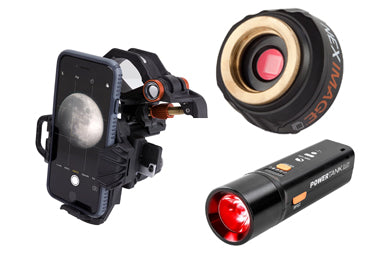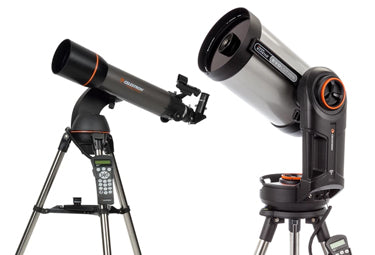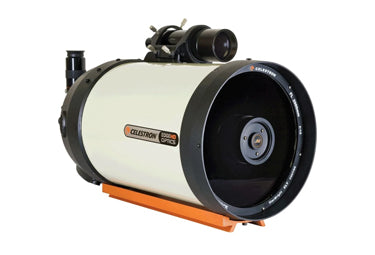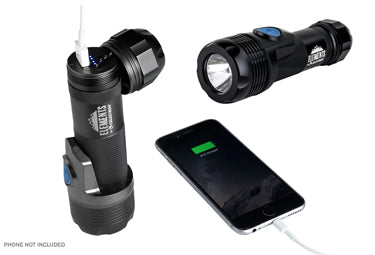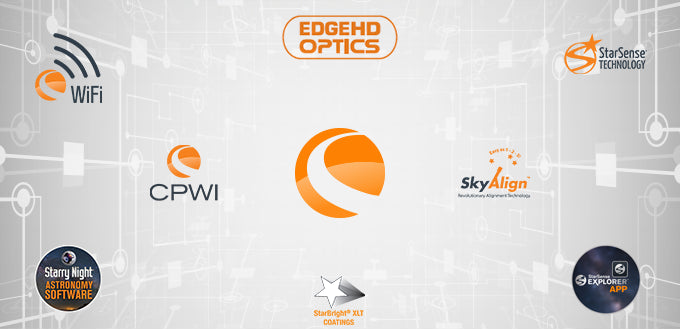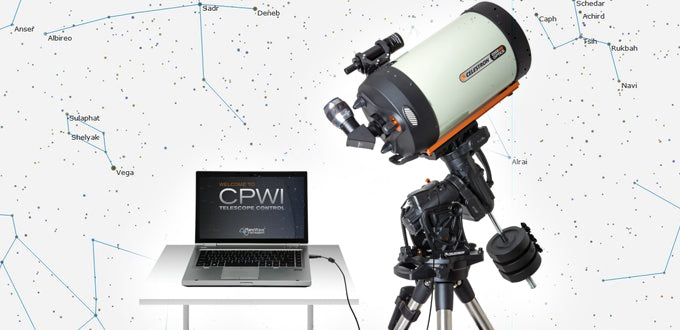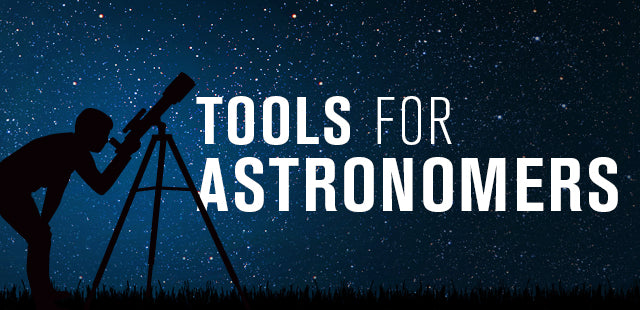Morning Comets and More Coffee!
November 3, 2013
This article is the part of a series on comets contributed by Tammy Plotner. Tammy is a professional astronomy author, President Emeritus of Warren Rupp Observatory and retired Astronomical League Executive Secretary. She was the first woman astronomer to achieve Comet Hunter’s Gold Status.
Regardless of whether you stay up late or get up early, right now is the time to enjoy a plethora of bright comets. It isn’t often that there is a comet which can be easily seen with smaller backyard telescopes—and we currently have not only one, but four to enjoy! Why not put on some coffee and see what’s out there to catch before the dawn’s early light?
Discovered on September 21, 2012, by Artyom-Kislovodsk and Vitaly Nevsky using the International Scientific Optical Network's (ISON) 0.4 meter reflector, Comet 2012 S1 ISON has probably been one of the most widely discussed Oort Cloud visitors in a long time. Will it be as bright as expected? Will it break up? Questions and controversy abound, but the sheer joy of having a comet to observe should eclipse all the talk! Why waste an opportunity when you could be out there, checking it out for yourself? Check out this photo of ISON taken on October 26:
 Credit: John Chumack (galacticimages.com)
Credit: John Chumack (galacticimages.com)
As you can see, the nucleus of Comet ISON is quite strong and the coma is estimated to be about 3 to 4 arc minutes in size with the tail extending out of the frame. At roughly magnitude 9, this makes the comet about twice the size and nearly the same brightness as the Ring Nebula (M57)! Needless to say, it would still be a difficult object for larger binoculars, but it is well within the capabilities of the average 114-150 mm reflector and possible a 102 mm refractor telescope. If you don’t know when to catch ISON, here are some key dates chosen by either when the sky will be dark or the comet passes near a celestial landmark:
- November 7 - Comet ISON passes less than a degree away from Beta Virginis. The comet will be located at RA 11 47 04.8 - Dec +01 46 57 and within reach of small optics at magnitude 7.
- November 10 - Comet ISON will be located at RA 12 08 32.6 - Dec -01 05 09 at an estimated magnitude of 6.6.
- November 14 - Comet ISON is located less than a degree away from 10th magnitude galaxy NGC 4697, making it an excellent target for astrophotographers. You'll find it at RA 12 42 48.9 - Dec -05 35 47 at magnitude 6, where it’ll be viewable with an average pair of binoculars.
- November 18 - Comet ISON passes less than half a degree away from bright star Spica (Alpha Virginis). It will be located at RA 13 24 59.4 - Dec -10 48 47 and be just on the edge of unaided eye visibility at magnitude 5.
- November 20 - Comet ISON is located at RA 13 49 27.5 - Dec -13 34 19 at an estimated magnitude of 4.4.
- November 23 - Be sure to get up early to catch it now! Comet ISON is located just slightly under 5 degrees SSW of planets Mercury and Saturn. It will be located at RA 14 30 41.6 - Dec -17 38 00 and be faint, but visible to the unaided eye at magnitude 3.5.
- November 25 - Comet ISON (RA 15 01 27.5 - Dec -20 05 10) joins Comet 2/P Encke. The two should be located less than 2 degrees apart, but widely separated by magnitude!
- November 28 - Comet ISON reaches perihelion at ~18:00 PM EST/ 23:00 UT.
- November 29 - If Comet ISON doesn't break up, it should reach its brightest estimated magnitude (-4.5) at RA 16 23 17.5 - Dec. -19 52 52.
As you may have noticed on November 25, Comet ISON will also be very near a returning traveler who recently reappeared on the scene: Comet 2/P Encke. It was first put on record in 1786 by Charles Messier’s assistant, Pierre Mechain, but it wasn’t acknowledged as the second periodic comet until 1819 when its orbit was computed by Johann Franz Encke. It is the shortest journeying comet of all, returning every three years; through sheer coincidence, this year happens to be one when it reaches perihelion! Let’s take a look at Encke captured on October 26:
 Credit: John Chumack (galacticimages.com)
Credit: John Chumack (galacticimages.com)
While Comet Encke doesn’t have much of a tail yet, it is still a strong presence and is roughly a magnitude 8. Because it is still “firing up,” when viewed through a mid-sized telescope it will have a sharp, small nucleus and a relatively wide coma—very similar in appearance to a planetary nebula! So, when and where can you locate Encke? Let’s have a look at a few key dates:
- November 7 – Comet Encke will be located in the constellation of Virgo at RA 13 11 40.09 Dec +00 48 28.6 and be at an estimated magnitude of 7.5.
- November 10 – Brightening slightly to a rough magnitude of 7.3, you’ll find fast moving 2/P located at RA 13 28 17.20 Dec -02 59 24.2
- November 14 – Still moving quickly and approaching Mercury, Comet Encke is now located at RA 13 50 18.99 Dec -07 41 33.3 and should have reached a magnitude 7.2.
- November 18 – Nearing perihelion, Comet 2/P Encke is now about the brightest it will get at roughly magnitude 7 and is located just ahead of the rising Sun at RA 14 13 46.93 Dec -12 04 32.7. Look for it paired with Mercury!
- November 21 – Comet 2/P Encke is at perihelion and located 0.336 AU from the Sun. You’ll find it positioned directly between Mercury and Saturn. The little fuzzball will probably be quite washed out from sunrise!
- November 23 – Just past perihelion and still quite bright at an estimated 7.2 magnitude, Comet Encke is now located at RA 14 46 49.62 Dec -17 03 11.1.
- November 25 – Fading slowly and positioned at RA 15 01 04.59 Dec -18 48 56.2, Comet Encke is still well within range of large binoculars and small telescopes as it holds a respectable magnitude 7.5. It will share the morning skies with Comet ISON and the pair will be roughly 2 degrees apart. Mercury and Saturn also make a great pairing on this date!
- November 28 – As it heads away from the Sun (RA 15 22 56.10 Dec -21 08 33.3) 2/P has now gone back to nearly a magnitude 8. Chances are, it will be lost in the morning glow, but may still be accessible with photographic equipment.
Still having fun? Then don’t head back to bed just yet—there are even more morning comets to go around! A cometary newcomer arrived on September 9, 2013, discovered by Terry Lovejoy on CCD images obtained with a 20-cm f/2.1 Schmidt-Cassegrain reflector on two nights. The new comet has been designated C/2013 R1 (LOVEJOY). Faint? You bet. But it is within reach of larger amateur telescopes and it’s definitely on the move! Here’s a still image taken on October 26 and a listing of dates to check it out:
 Credit: John Chumack (galacticimages.com)
Credit: John Chumack (galacticimages.com)
- November 7 – You’ll find Comet Lovejoy located at RA 08 42 35.09 Dec +18 20 36.0 in the constellation of Canis Major at a rough magnitude of 10.2.
- November 10 – Speedy Comet R/1 has now buzzed its way between Cancer and Leo at RA 09 08 46.37 Dec +22 59 43.5 and brightened to magnitude 9.9.
- November 14 – Comet Lovejoy is still zipping along and located in Leo Minor at RA 09 54 58.69 Dec +30 01 18.6 and picked up another half a magnitude in brightness.
- November 18 – Located at RA 10 57 24.55 Dec +36 53 59.0, Comet R/1 Lovejoy is moving quickly against the starry background and is nearly a magnitude 9, well within reach of average backyard telescopes.
- November 21 – Still close to magnitude 9 and approaching Canes Venatici, you’ll find Comet R/1 Lovejoy located at RA 11 54 01.75 Dec +40 44 56.6
- November 23 – With luck, Comet Lovejoy has now come very close to its maximum estimated brightness (magnitude 9). You’ll find it located at RA 12 33 55.32 Dec +42 15 59.8
- November 25 – Still holding a magnitude 9, Comet R/1 Lovejoy will be flying along at RA 13 13 01.99 Dec +42 52 34.0. It is exiting Canes Venatici and heading like a bullet towards Bootes.
- November 28 – As the month ends, Comet Lovejoy is slowly beginning to fade, dropping to about magnitude 9.1. You’ll find the icy traveler located at RA 14 06 09.25 Dec +42 20 43.3.
While Comet Lovejoy rolled across that portion of the sky, another comet decided it was time to break the ice! Comet 2012 X1 LINEAR was a lowly magnitude 14 visitor in Coma Berenices until the unexpected happened—an outburst! As luck would have it, professional astrophotographer John Chumack, was on the scene and captured the event on camera. “It is over 100-fold brighter at 8th magnitude and expanding!” John observed of his encounter. “It was low on the horizon at dawn, and tough to get. It just cleared the trees at 7:07am in bright dawn light. I managed a couple of quick shots before my CCD was flooded completely with light.” Let’s have a look at John’s discovery:
 Credit: John Chumack (galacticimages.com)
Credit: John Chumack (galacticimages.com)
In Chelmsford, UK, amateur astronomer Nick James was also photographing Comet 2012/X1 LINEAR on October 26 with his 11-inch Celestron telescope. His observations show the comet’s coma expanding over a period of two days. “The coma’s diameter is increasing at a rate of 30 arc seconds per day,” commented James. “At a distance of 2.95 AU this corresponds to 65,000 km/day or a little less than 1 km/s.”
Discovered on December 8, 2012, by the Lincoln Laboratory Near-Earth Asteroid Research project, Comet X1 LINEAR wasn’t exactly predicted to be an exciting apparition, but it has certainly changed some minds, as well as the positions of observing telescopes. How bright will it get? Like ISON, we don’t know, but here is another list of “magic” dates and estimated magnitudes:
- November 7 – Comet X1 should be located in the constellation of Bootes at RA 13 48 23.17 Dec +21 52 44.9 and be within reach of large backyard telescopes at magnitude 12.5. Remember, these are pre-dawn conditions and observing will be difficult.
- November 10 – X1 LINEAR will be positioned at RA 13 56 28.14 Dec +21 20 20.6 and still around 12.5 magnitude.
- November 14 – Comet LINEAR will have moved significantly by this date and be located roughly at RA 14 07 23.77 Dec +20 36 23.8. Predictions have it slightly brighter at magnitude 12.2... not anywhere close to as bright as nearby Arcturus! (This is a case where a star could actually be considered light pollution.)
- November 18 – Brightening ever so slightly at magnitude 12.1, Comet X1 should be positioned at RA 14 18 29.48 Dec +19 51 37.7. It has now by-passed Arcturus and is heading towards Serpens.
- November 21 – Both moving and brightening slowly, the Comet LINEAR forecast for today is magnitude 12 and RA 14 26 55.19 Dec +19 17 32.2.
- November 23 – This date has Comet X1 LINEAR slightly brighter at magnitude 11.9 and positioned at RA 14 32 35.30 Dec +18 54 34.7.
- November 25 – Comet X1 appears almost to stall in terms of brightness and movement. It is still a rough magnitude 11.8 and located at RA 14 38 17.73 Dec +18 31 26.8.
- November 28 – Comet 2012/X1 LINEAR is still holding an estimated 11.8 magnitude and is located at RA 14 46 55.54 Dec +17 56 26.6.
Will this quartet of comets dazzle the eye? Perhaps ISON might, but realistically, the other comets won’t be as impressive. To the visual observer, they will appear as little more than small, round contrast changes, often resembling an elliptical galaxy or planetary nebula. There are even comets which look very much like an unresolved globular cluster. Because they don’t always stand out with a dramatic tail, splashy coma, and intense nucleus, you can see how comets were often mistaken as deep space objects many years ago. It’s no small wonder that Charles Messier created his famous list of “non-comet” objects!
Unlike a galaxy or nebula, comets are objects on the move. Since not everyone will be observing at the exact same time from the exact same location, that means the coordinates given here are only approximate and will get you in the general position. The same holds true of the magnitude values. Comets are volatile creatures and can change without notice. While you are observing, take the opportunity to make notes and do a rough sketch. It might seem like a bother at the time, but some day you may want these simple documents to help you achieve a comet-observing award. No matter what, with four great comets to be seen in the early morning sky, it’s a great time to brew another pot of coffee and enjoy the sunrise show!

